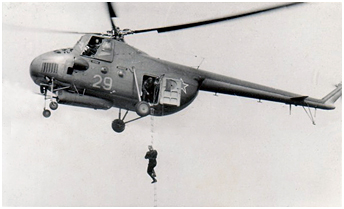
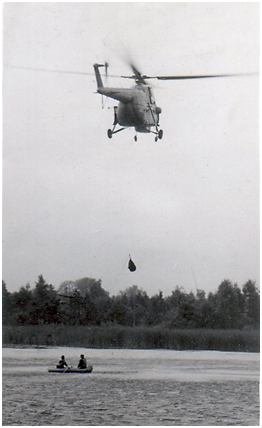 Un Mi-4A du 226.OSAP lors d'un exercice de sauvetage au-dessus de l'un des étangs entourant Sperenberg.
© L.Khandurin.
Un Mi-4A du 226.OSAP lors d'un exercice de sauvetage au-dessus de l'un des étangs entourant Sperenberg.
© L.Khandurin.
An Mi-4A of the 226.OSAP during a rescue exercise above one of the ponds surrounding Sperenberg. © L.Khandurin.
The first Soviet heavy transport helicopter produced in series was born from a directive issued by the USSR Council of Ministers dated October 5, 1951.
The latter stated that this helicopter should be capable of carrying 12 soldiers sitting on folding benches, a 57mm or 79mm cannon,
or a cross-country vehicle of the GAZ-67B or GAZ-69 type. The carrying capacity was to be 1200kg under standard conditions and 1600kg under overload conditions.
The first V-12 flying prototype, i.e. the future Mil' Mi-4 "Hound," was completed in late April 1952 in the Mil' experimental workshop at Plant n°3 in Moscow.
The Mi-4 was the first helicopter in the world to receive hydraulic booster flight control assistance. The serial production scheduled to take place
at Factory n°387 in Kazan' was already approved in December 1952.
The Mi-4 was powered by a Shvetsov ASh-82V 14-cylinder twin-row radial engine developing 1530hp in normal use and 1700hp for takeoff.
Military helicopters were generally equipped with a ventral nacelle housing a 12.7mm machine gun fed with 200 rounds (Complex K-48) attached to a NUV-1 flexible mount.
The two pilots were seated in a cockpit above the cargo hold that could be equipped with an additional fuel tank when necessary.
An LPG-2 electric winch was attached inside the cargo compartment, right above the side door (only one door on the left side). It could pivot to the outside when the latter was open.
The main rotor of the first Mi-4s had blades with a lifespan limited to 150 hours only. However, their longevity was gradually augmented
to reach 2500 hours in 1960, thanks to new manufacturing techniques that were used on other Mil' products successfully.
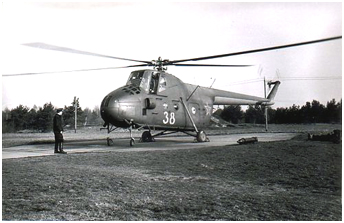
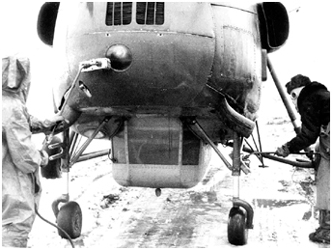 Series Mi-4s could accommodate 16 soldiers or 8 stretchers; a GAZ-69 "jeep," or two M-72 motorcycles with sidecar and 5 soldiers; a field gun with
its personnel and ammunition, or two 82mm mortars with their crew and 7 boxes of shells. Also, it was possible to carry 1300kg under sling.
Like the Mi-1 and the Mi-2 that were built or modified into different variants (see > 4.2 The Mi-2 "Hoplite"), the Mi-4 was
available in new versions, the purpose of which was adopted and developed by its successor, the Mi-8. Little is known about the career of the Mi-4 with the GSFG.
However, it is certain that most of the versions described below were deployed in the GDR.
Series Mi-4s could accommodate 16 soldiers or 8 stretchers; a GAZ-69 "jeep," or two M-72 motorcycles with sidecar and 5 soldiers; a field gun with
its personnel and ammunition, or two 82mm mortars with their crew and 7 boxes of shells. Also, it was possible to carry 1300kg under sling.
Like the Mi-1 and the Mi-2 that were built or modified into different variants (see > 4.2 The Mi-2 "Hoplite"), the Mi-4 was
available in new versions, the purpose of which was adopted and developed by its successor, the Mi-8. Little is known about the career of the Mi-4 with the GSFG.
However, it is certain that most of the versions described below were deployed in the GDR.
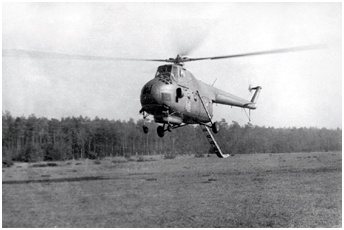
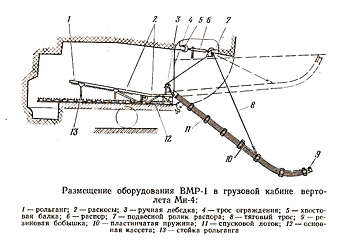 The Mi-4A (1956) military transport variant was clearly the most common. The troops on board could fire through openings in the portholes.
Mi-4As also were likely to be converted into a mining system simply by removing the rear clamshell doors of the cargo compartment
and installing a VMR-1 mining conveyor belt system. The end of the dispensing system protruded outside the cargo hold and the helicopter
flew at low speed and a few feet above the ground during mining operations.
The Mi-4A (1956) military transport variant was clearly the most common. The troops on board could fire through openings in the portholes.
Mi-4As also were likely to be converted into a mining system simply by removing the rear clamshell doors of the cargo compartment
and installing a VMR-1 mining conveyor belt system. The end of the dispensing system protruded outside the cargo hold and the helicopter
flew at low speed and a few feet above the ground during mining operations.
The Mi-4AV (Vooruzhennyy - Armed) entered service in 1968, although the first experiments with weapons began in 1958, when various
armaments and configurations were tested. The Mi-4AV used the K-4V weapon system. A rack accommodating three BDZ-57KRV pylons was attached to each side of the fuselage.
This structure was originally secured with explosive bolts, but this solution was not adopted at unit level. The range of weapons available was as follows:

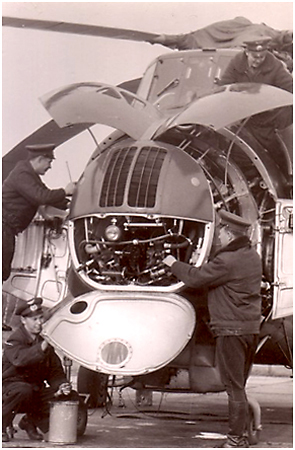 Entretien du moteur Chvetsov ACh-82V d'un Mi-4A du 226.OSAP. © L.Khandurin.
Entretien du moteur Chvetsov ACh-82V d'un Mi-4A du 226.OSAP. © L.Khandurin.
Maintenance operations on the Shvetsov ASh-82V engine of a Mi-4A from the 226.OSAP. © L.Khandurin.
- six UB-16-57UMV rocket pods
(16 57 mm S-5M rockets each)
- six 100kg bombs
- four 250kg bombs
- two ZB-500 napalm canisters
- guns or machine-guns
- a mix of these various armaments
In addition, four 9M17M Falanga (AT-2 "Swatter") antitank-guided missiles could be hung on additional pylons (two on each side) fixed above the standard armament.
According to official procedures, the pilot-navigator was responsible for launching missiles using a 9Sh121 optical sight; the captain (pilot) fired the
unguided S-5 rockets with a PKV foldable sight; the flight engineer fired the machine gun located in the ventral nacelle, in which he lay in a prone position.
He also dropped the bombs using an OPB-1R sight also located in the gondola. However, the pilot-navigator often dropped the bombs himself using his eyes as a sight.
Only 185 Mi-4A were converted into armed versions. The fact that this helicopter was underpowered once heavily armed (its range decreased from 455 to 340 km)
and the forthcoming entry into service of the Mi-8 were probably determining factors in this situation. These helicopters are
not to be confused with those operated by other nations such as the Czechoslovak
Mi-4V that were
equipped with four weapon pylons in total and could carry 16 RM-130-4 rocket tubes that could fire as many 130mm rockets or
more conventional UB-16-57 rocket pods.
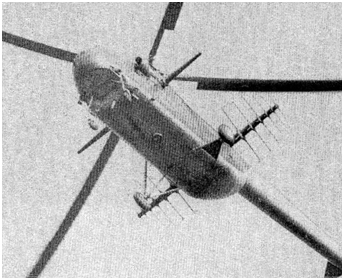 Cette vue d'un Mi-4MK photographié à Neuruppin en décembre 1977, permet de distinguer les mâts et antennes principaux de cette version de guerre électronique du
"Hound." © USMLM.
Cette vue d'un Mi-4MK photographié à Neuruppin en décembre 1977, permet de distinguer les mâts et antennes principaux de cette version de guerre électronique du
"Hound." © USMLM.
Main masts and antennas of the electronic warfare variant of the "Hound" can be observed on the underside view of this Mi-4MK, photographed at Neuruppin in
December 1977. © USMLM.
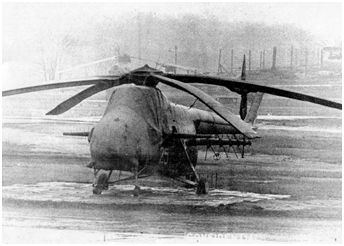 The first Soviet helicopters modified to carry out electronic countermeasure missions showed up in the early sixties.
They were Mi-4MK equipped with a Mayak-3 (Beacon) jamming system - hence their MK designation. They also were designated Mi-4PP (Postanovshchik Pomekh, jammer).
The first Soviet helicopters modified to carry out electronic countermeasure missions showed up in the early sixties.
They were Mi-4MK equipped with a Mayak-3 (Beacon) jamming system - hence their MK designation. They also were designated Mi-4PP (Postanovshchik Pomekh, jammer).
The Mi-4GR (1963) was equipped with a Grebeshok-3 (Cockscomb) monitoting and radio-relay complex. This helicopter modification was probably deployed in very small quantities
if we judge by the small number of Mi-8s that were subsequently converted to implement the Grebeshok-5 suite. Unlike
Mi-8R and Mi-10GR
that were equipped with folding radomes, the Mi-4GR had smaller antennas under the nose and the rear fuselage.
The Mi-4TARK (Televizionnyy Aviatsionnyy Razvedyvatel'nyy Kompleks or Airborne Television Reconnaissance Complex) was an artillery adjustment and reconnaissance variant developed in 1963-64.
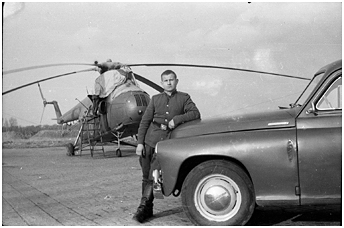
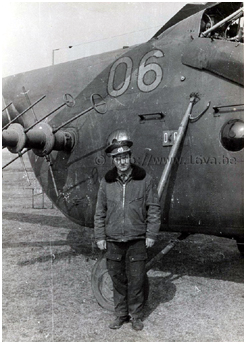 The first operational Soviet airborne command post helicopters also showed up in the early sixties.
The Mi-4KK (also designated Mi-4VKP - Vozdushnyy Kommandnyy Punkt or Airborne Command Post) were ground-deployable mobile command posts.
Beside additional antennas, these helicopters had antenna masts for ground operations attached to the right fuselage side.
No ventral gondola was present (> Photo).
The first operational Soviet airborne command post helicopters also showed up in the early sixties.
The Mi-4KK (also designated Mi-4VKP - Vozdushnyy Kommandnyy Punkt or Airborne Command Post) were ground-deployable mobile command posts.
Beside additional antennas, these helicopters had antenna masts for ground operations attached to the right fuselage side.
No ventral gondola was present (> Photo).
The Mi-4KU (also designated Mi-4VzPU - Vozdushnyy Punkt Upravleniya or Airborne Control Post) were flying command posts used to
control the air units supporting ground forces. This variant was equipped with the PUNAV "Kenguru" system.
It had no ventral gondola.
Finally, the Mi-4S (Salon) - was that variant equipped with rectangular windows ? - featured a VIP interior for six people and an extended communications suite.
This modification of the "Hound" was used to carry senior officers. Three helicopters of that type would have been based at Sperenberg during the mid-sixties
(1).
 |
Mi-4 PHOTO PAGE |  |
notes
(1)
A witness details the composition of the third squadron from the 226.OSAP between 1963 and 1965 as follows:
1- B/N 26 (s/n 09127)
2- B/N 27 (s/n 0504)
3- B/N 28 (s/n 1686) Salon - equipped with seats
4- B/N 29 (s/n 0987)
5- B/N 30 (s/n 0314)
6- B/N 31
7- B/N 32
8- B/N 33
9- B/N 34 (s/n 0450)
10- B/N 35
11- B/N 36 "Rym-B" system
12- B/N 37 (s/n 0281) "Rym-B" system
13- B/N 38 (s/n 18153) "Kenguru" system
14- B/N 39 (s/n 20153) "Kenguru" system
15- B/N 40 Salon
16- B/N 01 Salon
Entries without remarks are supposed to indicate Mi-4A models.
Mi-4 n°36 and 37 would have been equipped with the unknown "Rym-B" system. Nothing particular can be observed on the picture of n°36 >
here.
B/n 38 and 39 equipped with the "Kenguru" system were probably two different helicopters, i.e. one Mi-4KK and one Mi-4KU.
One will notice that there were three "Salon" versions. The witness added the mention "equipped with seats" for n°28.
Perhaps was it an ordinary Mi-4A modified with normal seating instead of benches. That was perhaps also the case for the two other helicopters,
unless they were dedicated models with rectangular cabin windows - one will note n°01 with an out of sequence bort number.
 |
Plan du site - Sitemap |  |
